MXA MOTOCROSS RACE TEST: 2018 HUSQVARNA FC250
Q: FIRST AND FOREMOST, IS THE 2018 HUSQVARNA FC250 BETTER THAN THE 2017 FC250?
A: Yes. The 2018 Husky FC250 is a refined version of the 2017 model. The 2018 FC250 got all the same updates as the 2018 KTM 250SXF (save for the orange frame). Overall, the 2018 FC250 is a better-suspended and more durable package than the 2017 version.
Q: WHAT DID HUSKY CHANGE ON THE FC250 FOR 2018?
A: WP’s goal is to get its AER air forks as good as Yamaha’s Kayaba SSS suspension components. Why? Because the SSS coil-spring forks work well for just about any weight, speed or skill level. WP is closing the performance gap on SSS and has surpassed the red, green and yellow competition’s forks—and saved 3 pounds in the process. Other than fork changes, Husky updated the battery and made durability updates to the clutch, shifting, radiator guards and transmission bearings.
(1) Forks. The WP AER air fork has been updated with a new air seal, air piston and rebound spring. On the damping side, there is a revised piston. The valving has also been updated.
(2) Shock. The WP shock has new settings to match the updated fork settings.
(3) Battery. A bigger Sky Rich HJTZ5S-FP battery (0.9 pounds) has replaced the previous Samsung C22S battery. In cold weather, the Samsung battery would have to be primed to start the bike. The Sky Rich battery does not. If you need/want an extra battery for your 2018 KTM or Husky, just go to www.skyrichbattery.com. They retail for $87.60.
(4) Clutch plates. The steel clutch plates now go through a process called nitriding. Nitriding is a heat-treatment process that diffuses nitrogen into the surface of the plates to create a case-hardened surface.
(5) Radiator guards. Husky’s radiator guards have been redesigned to provide improved airflow and mud release in heavy conditions.
(6) C4 bearing. The transmission has gone from a C3 to a C4 bearing. This change has a bigger tolerance than the C3 bearing and improved performance under high loads, rpm and temperatures.
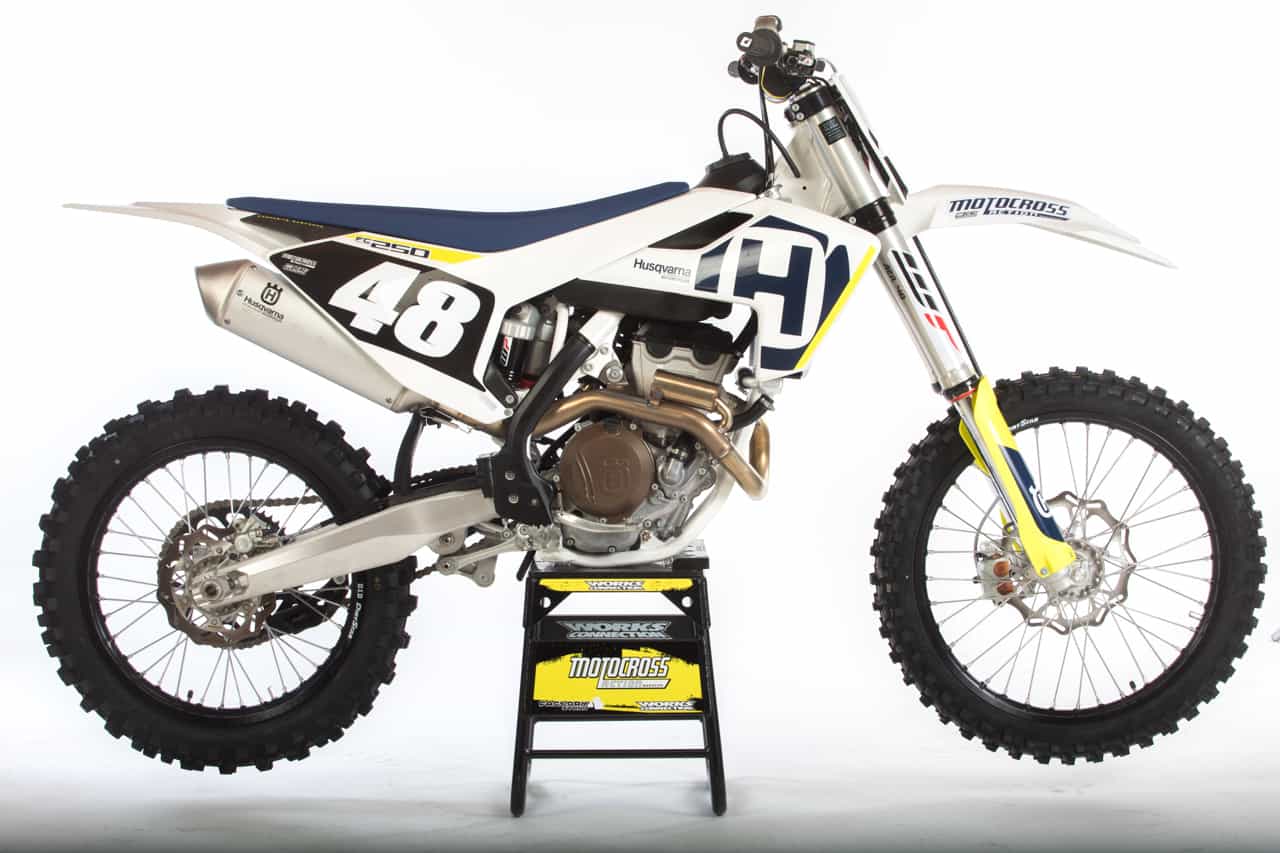
(7) MIM shift star. The shift star is now Metal Injection Molded (MIM) to provide better wear characteristics via a stronger surface.
Q: WHAT REALLY MAKES THE FC250 DIFFERENT FROM THE KTM 250SXF?
A: It is no secret that the KTM 250SXF and Husky FC250 share the exact same engine, suspension and chassis; however, when racing the Husky and KTM back to back with the exact same settings, they feel like two different machines. Here are the reasons why.
(1) Handlebars. Most MXA test riders like the Pro Taper bars on the FC250 better than the Neken bars on the KTM 250SXF. The Pro Taper Husky bars are 2mm shorter and 2mm lower, with 2.5mm less rise and 3mm less sweep. The difference comes more from the greater resilience of the Pro Taper bars than from the dimension changes.
(2) Seat height. The seat height on the FC250 is about 5mm lower than on the 250SXF. The seat foam is also a 1/2-inch lower in the meat of the seat. This makes the FC250 seat blockier and harder. Additionally, with handlebars that are 2mm lower and a seat that is 5mm lower, we are dealing with some dimension changes that make the Husqvarna feel completely different from the KTM.
(3) Seat length. The FC250 seat, from bow to stern, is 1-1/2 inches longer than the KTM 250SXF seat.
(4) Hips. At the hips, the FC250 is about an inch wider. It actually feels more like 4 inches, because the FC250 gets wider from the pegs back. The 250SXF only feels wider on the exhaust side.
(5) Airbox. It is just conjecture, but it seems as though KTM is sabotaging Husqvarna when it comes to power output. Why else would KTM, who owns Husky, have them suffocate the FC250 with an almost fully enclosed airbox. Plus, on the FC350 and FC450, Husqvarna’s engineers spec’ed a muffler with restrictive internal cones that reduce low-end throttle response. What’s strange about these mufflers is that they were used on KTMs back in 2013 but dropped in 2014 because they hurt the powerband. Yet, here they are on the 2018 FC350 and FC450.
(6) Subframe. The FC250’s subframe is made of a plastic carbon material, unlike KTM’s subframe, which uses traditional aluminum tubing. This gives the Husky a more forgiving rear end.
(7) Swingarm. The swingarm looks different from the KTM swingarm. It seems like there is less material on the Husky swingarm, which would lead us to think it would have more flex. But, according to Husqvarna, it is actually more rigid.
(8) Price. Husqvarnas cost $100 more than KTMs.
(9) Rims. The entire Husky FC and TC fleet comes with D.I.D DirtStar rims, while KTMs come with unlabeled Excel Takasago rims. They do, however, share the same spokes, nipples and CNC-machined hubs. We prefer the DirtStar rims.
(10) Brakes. Husqvarna uses GFK brake rotors. KTM uses Galfer rotors. There is a slight difference in weight but no difference in stopping power.
(11) Clutch. Unlike the KTM, which uses a Brembo clutch lever, master cylinder and slave unit, the Husqvarna uses Magura components. We don’t like the reliability of the Magura slave unit, but some test riders liked the Magura’s buttery feel.
(12) Muffler. Although the muffler is the same length, the shape of the canister is different.

Q: DO THESE DIFFERENCES MAKE THE FC250 BETTER OR WORSE THAN THE 250SXF?
A: There is give and take between the two brands. Some things are better while others are worse. Maybe sabotage is the wrong word, but either KTM’s corporate owners are handicapping Husqvarna or the Husqvarna engineers need to go back to engineering school.
Weight. The FC250 is 2 pounds heavier due to the molded plastic airbox, beefier swingarm and proprietary plastic design. Do you feel it on the track? No, but 2 pounds is 2 pounds. Having said that, the beefier swingarm and three-piece molded subframe calm down the feedback from the rear end significantly. You feel this most when accelerating over chop while sitting down. This is a plus over the KTM, even though the added weight is a negative.
Power. The two engines are clones of each other. The only things different about the mechanical parts are the Magura clutch slave unit and the color of the clutch and ignition covers; however, on the track and on the dyno, they are different. This is not a function of the piston, cams, exhaust or valves. It all comes down to the airbox.
On paper, the FC250 makes 20.73 foot-pounds of torque and 44.38 horsepower. That makes it the most powerful bike in the 250 class (coming in 0.59 ponies ahead of the KTM 250SXF). What the dyno doesn’t show, and what you feel on the track, is a reduction in low-end power, a weaker low-to-mid transition and a longer rev time. All the blame for the mellow power delivery, albeit abundant power output, comes down to the FC250’s restrictive airbox that makes the engine gasp for air at low rpm.
Handling. Due to the discrepancies in the height, length and firmness of the seat and the less rigid subframe, the FC250 has to be set up differently from the 250SXF to get the same results. When the suspension settings are set up identically on both bikes, you get different feedback. The FC250 is more roomy in the cockpit, as the seat height is 5mm lower. The 2mm-lower bars make up some of that difference, but that 5mm makes a big change to the weight distribution when riding, especially when in the saddle while turning or accelerating. We raise the sag 2 to 5mm or slide the forks 3mm higher up than on the 250SXF to compensate for the lower seat. This allows the FC250 to match the cornering of the 250SXF from the middle out.
Ergonomics. The FC250 feels wider between the legs. Some riders don’t like this, but you can use it to your advantage, using less energy by gripping the wide side panels to hold your body forward while standing. The flatter and longer Husky seat suits bigger riders better than smaller ones. The biggest ergonomic complaint about the 2018 KTM 250SXF is the bar bend, thus there are MXA test riders who run Husky-bend Pro Tapers on their Katooms.
Bodywork. The biggest visual difference between the Austrian brothers is their bodywork. The no-tools Husky one-piece side panel is a very cool design, but regardless of how much we like the left-side bodywork, it doesn’t make up for how much we hate the right-side bodywork. Our complaints focus on the bolt that has to be taken off to remove the “almost” no-tools side panel. Once that bolt is taken out a few times, it damages the bolt hole and loses the spacer. Why do we find this so irritating? We can’t adjust the high-speed compression dial without removing the panel. Conversely, we are not fans of the right-side KTM side shroud, either, but at least you can make shock adjustments.

Q: WHAT ARE THE WORST ATTRIBUTES OF THE FC250, AND CAN THEY BE FIXED?
A: The FC250 has a few small things that bother us, but there are four things we just can’t live with.
Slave unit. The FC250 Magura clutch slave unit will fail—and we say this with all certainty. The lip seal is easily damaged and will leave you without a clutch when it is least convenient (by that we mean when you are riding the bike instead of when you are waxing it). When yours fails, go to a KTM dealer and order their Brembo slave rebuild kit. It will fit perfectly in the Magura slave unit. The Brembo slave unit comes with an O-ring that is much more dependable than the lip seal.The Brembo piston has a much better seal than the Maguras. The KTM part number for the slave unit rebuild kit is 5483-2066-000. It retails for approximately $50.

Airbox. The closed-off airbox mutes the power from bottom to mid. Drill holes in the airbox cover or cut out the right side of the airbox (behind the side panel) to get the KTM effect. We do both.
Gearing. We hate the FC250’s 14/51 gearing combo with a passion. We didn’t like it on the 2018 KTM 250SXF, either, but it didn’t affect the orange version as much as the Husky. The fix? Buy a 13-tooth countershaft sprocket immediately. You can thank us later. It makes a world of difference.

Mapping. You can technically choose from four different maps on the multi-switch. Map 1 is the standard map. Map 2 is the aggressive map. TC (Traction Control) is engaged on the upper button. TC sounds like a trick feature, but it still needs some work, especially on a 250cc four-stroke. Pressing both the TC and map buttons at the same time engages Launch Control. It knocks off some horsepower above 7000 rpm to help the tire hook up off the gate.
What do we think of the four map possibilities? Map 1 diminishes the already-soft bottom-end power. We rarely use it on the FC250 compared to the FC350 and FC450. Map 2 is the only map that the MXA test riders ever selected. We’d like to think that an entry-level rider would benefit from Map 1, but why would a beginner buy a Pro-level 14,000-rpm bike in the first place. As for traction control and launch control, they could both help on a muddy day or if your track resembles pavement. KTM needs to make Map 1 its low-to-mid map by designing it to punch up the bottom instead of just detuning the whole powerband. Most riders won’t scream bloody murder at 14 grand anyway. Taking from the top and placing more down low would be a usable map for the masses.

Q: HOW ARE THE WP SUSPENSION COMPONENTS?
A: In the past WP has always been two steps behind KTM. Even though WP and KTM are owned by the same company, you would think they were working against each other. For years WP was KTM’s worst enemy. The stuff just didn’t work. WP blamed the KTM frame, which WP made to KTM’s specs, while KTM blamed WP’s suspension. We know who was to blame, because we mounted Kayaba SSS forks on our KTMs—and that made all the difference in the world.
Suddenly, WP got smarter. The release of the WP AER air forks put the two companies on the same page. The WP AER air fork is the people’s fork. It is light, easy to use and works well for a wide spectrum of riders. The updates for this year allow the forks to ride higher in the stroke so they don’t dive as much. The WP shock works in harmony with the WP forks. The Husky shock isn’t as twitchy as before and stays planted better than the 250SXF rear end. Test riders tend to favor the front end as the forks outperform the shock.
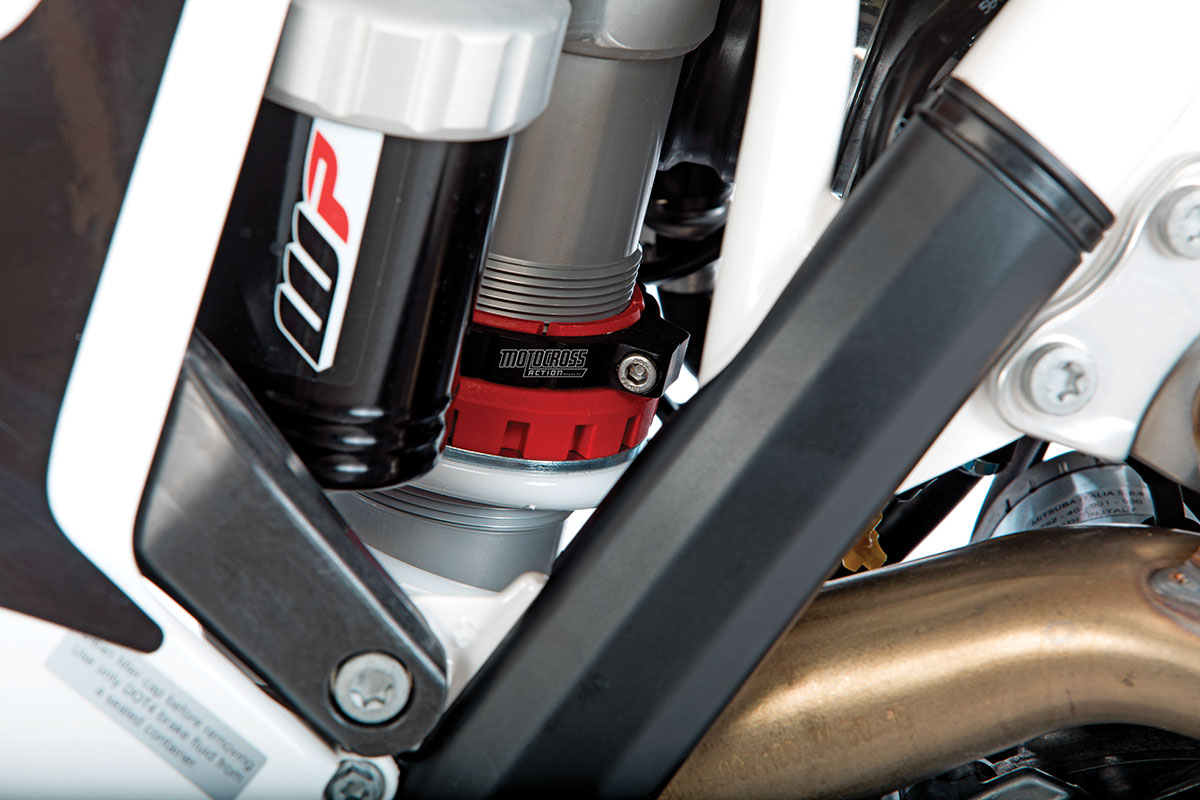
Q: WHAT DID WE HATE?
A: The hate list:
(1) Gas cap. It has a better grip shape than the KTM gas cap, but it still sticks.
(2) Exhaust. You have to remove the shock to get the pipe off. Like jigsaw puzzles?
(3) Sprocket bolts. We don’t have as much of a problem as we used to, but they still come loose.
(4) Gearing. The ultra-tall 14/51 is horrible. Change the 14-tooth countershaft to a 13 immediately.
(5) Spokes. The majority of spokes will seat over time, but nine times out of 10 the spoke next to the rim lock will be loose.
(6) Side panels. We love the no-tools left-side shroud but despise the right side (it is designed to slip off without tools, but an 6mm T-handle is required to actually get it off). Husqvarna could at least make it so we can adjust the high-speed compression without having to take it off.
(7) Shock collar. Over time our anger has diminished. Now we are numb. We are tired of complaining about it.
(8) Torx. Don’t buy a KTM without buying a full set of Torx. You won’t be able to work on your bike if you don’t.
(9) Maps. We like the aggressive map. The stock map and the traction control switch have similar qualities. They both lack bottom-end power. This engine needs a map with more bottom and mid, not less.
(10) Slave unit. The Magura slave unit seal will fail. We know this is true, because we have had several failures. Don’t let your Husky dealer put in a Magura seal kit. Have him order a Brembo rebuild kit instead.
Q: WHAT DID WE LIKE?
A: The like list:
(1) Handling. It is hard to beat a bike that handles as effortlessly as the FC250.
(2) Hydraulic clutch. We like the feel of the Magura hydraulic clutch; it’s smoother than the Brembo clutch. Unfortunately, it could go out on day one, day 30 or day 100, but it will go out.
(3) Weight. The FC250 is the second-lightest bike in its class at 220 pounds, losing out only to the KTM 250SXF by 2 pounds.
(4) Power. Once you change the gearing and drill holes in the airbox, the power will be identical to what the KTM 250SXF makes. Either way, both the FC250 and 250SXF make four horses more than their competition.
(5) Hour meter. “How long has it been since the last top end job?” Just check the stock hour meter behind the front number plate.
(6) Air filter. It is painless to change.
(7) AER forks. These forks are awesome. They work great for Beginner- to Pro-level riders without having to get them re-valved.
(8) Grips. We love the ODI lock-on grips. We just wish they weren’t mounted with a #15 Torx.
(9) Tires. The FC250 is shod with our favorite Dunlop MX3S tires front and rear. Beware, the front tire’s sidewall knobs will start to peel off within 10 hours if ridden on hard-packed dirt.
(10) Brakes. The best in the business.
Q: WHAT DO WE REALLY THINK?
A: Until Husky opens the airbox so the FC250 can run like a KTM 250SXF, it will play second fiddle to its brother. The good thing is, all you need to make your Husqvarna just as fast as the KTM is an electric drill. After that, the FC250 offers better wheels, better handlebars and a more forgiving rear end than the 250SXF. If KTM gave Husqvarna the same airbox, like they gave them the same forks, shock, frame and engine, the FC250 would have a fighting chance.
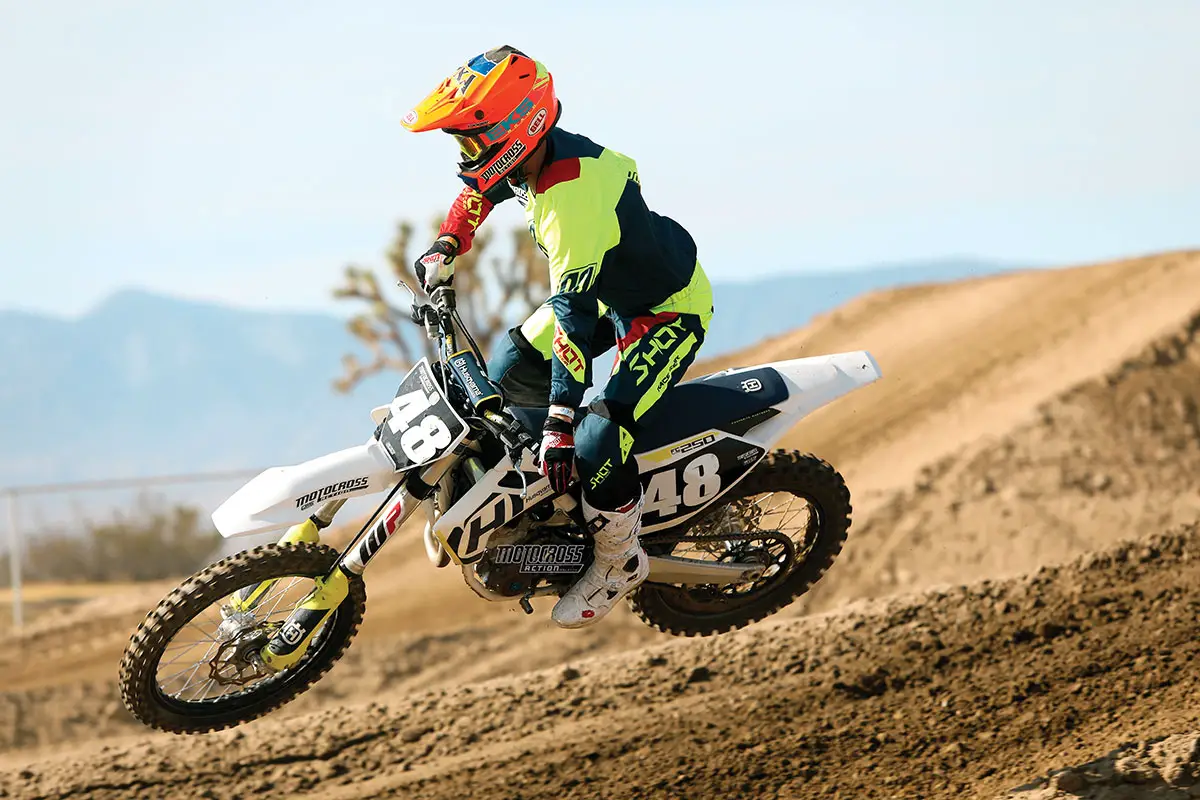
MXA’S 2018 HUSQVARNA FC250 SETUP SPECS
This is how we set up our 2018 Husqvarna FC250 for racing. We offer it as a guide to help you find your own sweet spot.
WP AER FORK SETTINGS
It’s important to note that any recommended air-fork setting is totally dependent on the weight and speed of the rider. MXA tries to choose middle-of-the-road air pressure that works for a wide variety of skill levels. The trick to getting the most from your WP AER air forks is finding the proper air pressure for your weight, speed and track. We’ve gone as low as 130 pounds, but we typically start testing at the OEM-recommended air pressure and then lower it in 2-psi increments until the forks don’t feel like they are dropping into their stroke. Typically, AER forks ride high in their stroke with the stock pressure. Once we find the right pressure, we focus on clicker changes. For hardcore racing, we recommend this fork setup on the 2018 FC250 (stock specs are in parentheses):
Spring rate: 150 psi (156 psi)
Compression: 20 clicks out (17 clicks out)
Rebound: 15 clicks out (17 clicks out)
Fork-leg height: Third line
Notes: Some riders felt like the bike stood up in the middle of corners. If this is happening to you, raise the forks 3mm up from the third line. Except for extreme temperature changes, you should not have to change the AER’s air pressure as often as on other air forks; however, we do bleed the outer chamber constantly, which is accessed via a 10mm hex head or #20 Torx. Even if you own a #20 Torx, don’t use it on the air-side leg, because the aluminum bleed screw strips out easily.
WP SHOCK SETTINGS
We turned the high-speed compression in a turn from stock to keep the rear end from dropping. For hardcore racing, we recommend this shock setup for the 2018 Husky FC250 (stock specs are in parentheses):
Spring rate: 42 N/m
Race sag: 102mm (105mm)
Hi-compression: 1 turn out (2 turns out)
Lo-compression: 13 clicks out (15 clicks out)
Rebound: 14 clicks out (15 clicks out)
Notes: The rear of the Husky is lower than that of the KTM. We raised the race sag up a few millimeters—from 105mm to 102mm—to compensate.
Crash photo by Rommel Andrade
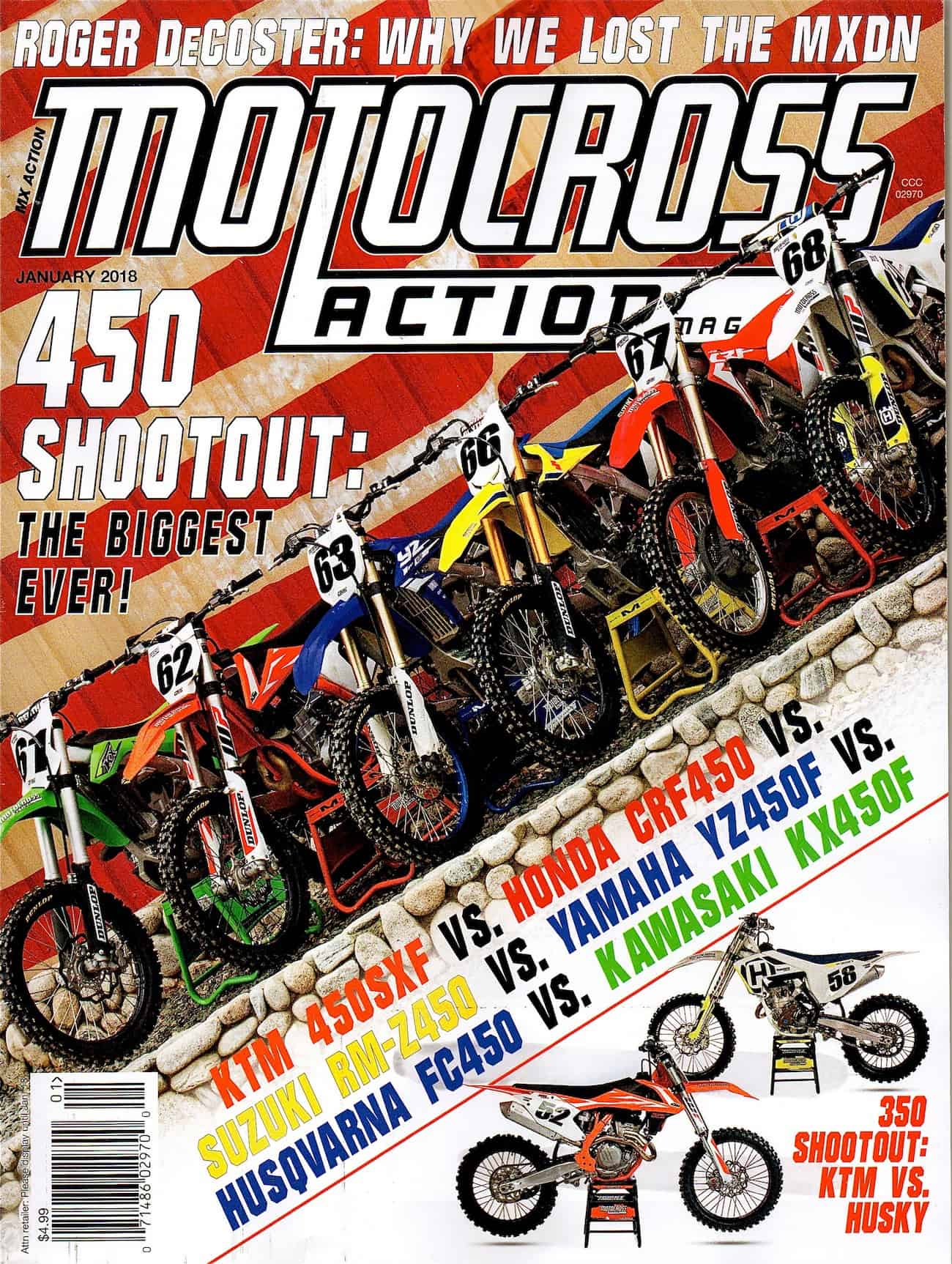 Had you subscribed to MXA, you would have read this complete bike test when in came out back in December. Click the box below to subscribe.
Had you subscribed to MXA, you would have read this complete bike test when in came out back in December. Click the box below to subscribe.



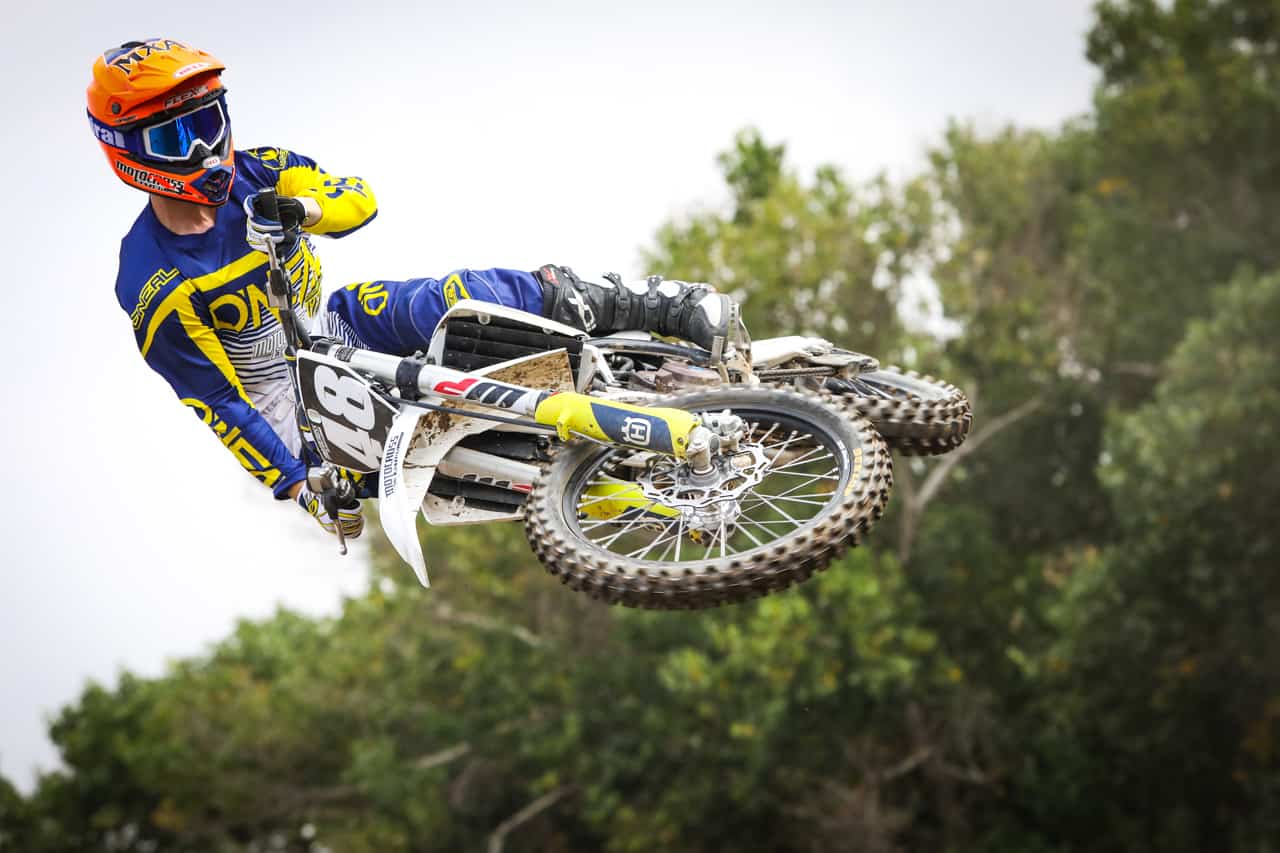



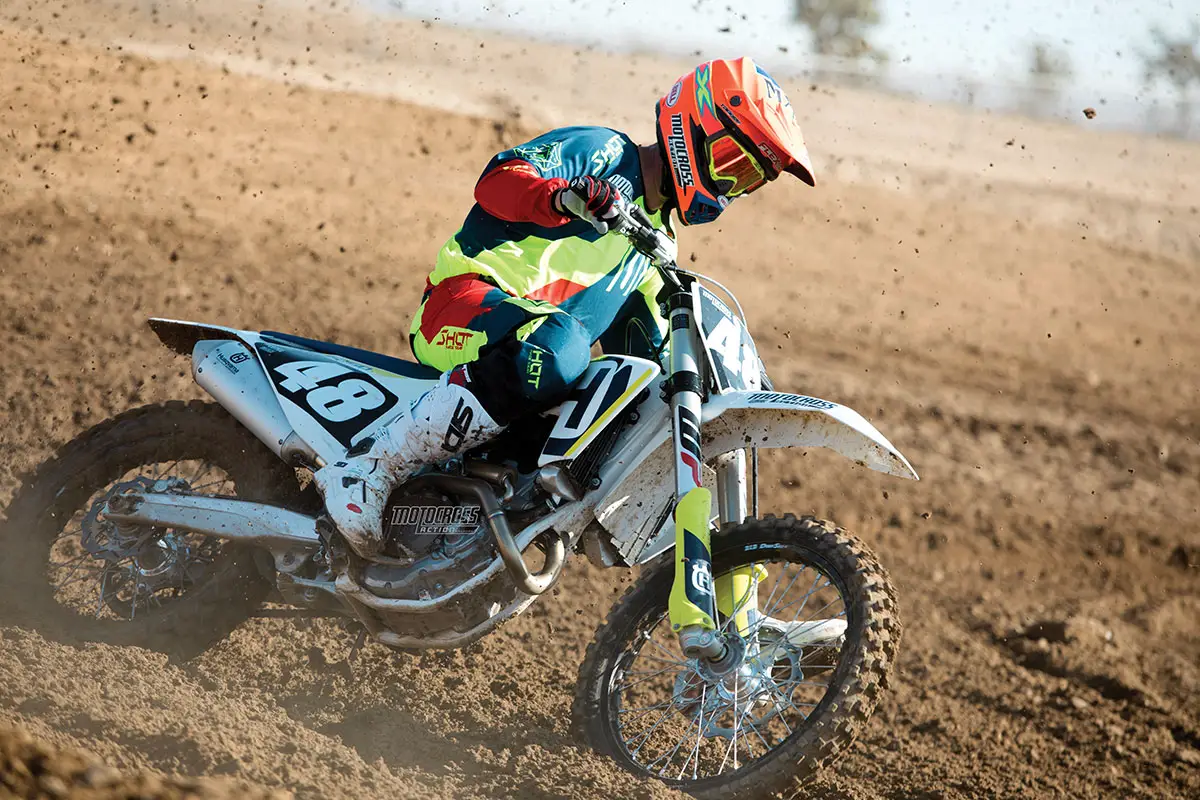


Comments are closed.